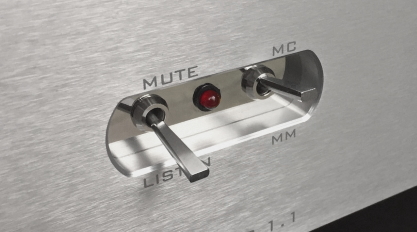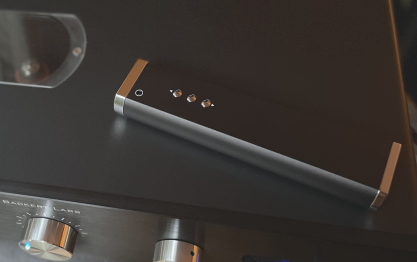
Although we love the music that pours out of our linestages and phono stages, we know that “nobody’s perfect” — here are some of the thoughts that have been communicated to us by reviewers and customers:
 Toggle switches. Some reviewers and customers have said that we should replace the toggle switches on the front of our preamps with push-buttons. It’s true that toggle switches can break off if you give them a good swipe. We are happy that some reviewers have praised them (“I love toggle switches!”). But other reviewers and some customers have registered displeasure (“there is only one thing I don’t care for on the Rhumba – those paddle switches”).
Toggle switches. Some reviewers and customers have said that we should replace the toggle switches on the front of our preamps with push-buttons. It’s true that toggle switches can break off if you give them a good swipe. We are happy that some reviewers have praised them (“I love toggle switches!”). But other reviewers and some customers have registered displeasure (“there is only one thing I don’t care for on the Rhumba – those paddle switches”).
Our view is that the best designs are functional, clean and modern, with a dash of retro elegance. For us, these strike the right balance. But we understand that they might not be for everyone.- No Backert Labs power amp to go with it. We are known as the preamp specialists. That means that we will not be offering power amps or other equipment. Some customers wish that we would, and we understand this. But we feel that preamps are often the biggest bottleneck preventing a stereo from communicating the true feeling of musical recordings. It is here that we are meant to contribute. As for what kind of power amp you should pair with a Backert Labs (for example, tubed vs. solid-state), we simply recommend that you buy the power amp that is the best-sounding to you, consistent with your budget and practical requirements. There are no “special synergies” that we have with certain brands or styles of power amp.
- Too darn expensive. We realize that not everybody can afford a new Backert Labs. We truly wish everyone could enjoy one, but it’s important to us that we build each preamp ourselves, in the US.
It’s also important to us that every circuit board is designed and made in the US, and every piece of metal comprising the chassis is machined, finished and anodized in the US. (This goes for all powder coating and the acrylic tube access door as well.)
We don’t use assembly shops. We don’t have our chassis made for us overseas. - “No bass or treble controls, no DAC included, no digital display,” etc. We build our preamps with a “minimalist” approach. We do this because sound quality is our primary goal. Our view is that adding features like digital displays or bass and treble controls can impair sound quality. In some cases the negative effects of such features are extremely minor or negligible. We still avoid them. But we understand that added features are often desirable, and it can be more convenient to see a volume level of “63” rather than “10:15 on the volume knob”.
 Remote only has volume up and down, and mute. Some products put more features on their remotes, and these can definitely be convenient. But they require more “stuff” inside our chassis that (again) creates opportunities for impairment of sound quality. We prefer to keep it simple.
Remote only has volume up and down, and mute. Some products put more features on their remotes, and these can definitely be convenient. But they require more “stuff” inside our chassis that (again) creates opportunities for impairment of sound quality. We prefer to keep it simple.- Too heavy. Our flagship Rhythm preamp is over 30 lbs. All of our preamps utilize thick aluminum in the chassis, and substantial 6061 aluminum face plates, with the metal sourced from Pennsylvania and machined in Pennsylvania. In fact, every single panel on the chassis of the Rhythm is machined from aircraft quality 6061 aluminum billet. We use this because it looks and sounds the best, but we understand that it’s not easy to quickly set one of these into your stereo rack.
- Too light. We have experimented with making our chassis out of different metals. For example, building the chassis with steel noticeably increases weight, and the “heft” factor that some people love. However, in our listening tests we have found that aluminum clearly outperforms steel, from a purely sonic perspective. In fact, it’s not even close. Since sound quality is the most important factor for us, we stick with aluminum.
- Phono preamp doesn’t have the _____ that I want. Our phono preamp might not offer the exact MC loading option that you prefer, although it does have 15 loading options. It also does not offer capacitance tweaks for MM cartridges. Further, the MC load is selected by inserting RCA plugs on the back, rather than using a remote control — see photo below. If you have multiple tonearms and want 2 dedicated MC inputs… ours has 1 MC, and 1 MM. However you can still achieve 2 MC inputs, by running a dedicated MC step-up transformer into the MM input. Some of our customers actually prefer this, as it allows them to use a super-high-quality MC step-up if they choose. Finally, our phono may not have the exact gain you’re looking for, although it does offer 41 dB and 47 dB for MM; and 61 dB and 67 dB for MC.

Conclusion. As you can see, the reason for many of these points is that we choose to do things in a minimalist way that leads to the best possible sound quality in most situations. It’s just who we are.
We are music lovers. And we hope this comes through to you as you listen to your favorite music with a Backert Labs.
Questions? You can always give us a call, or write to us at c o n s u l t @ b a c k e r t l a b s . c o m.

